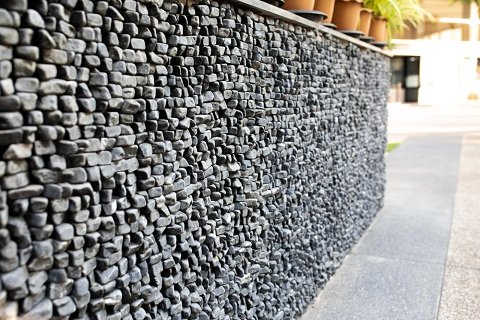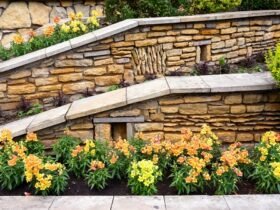Retaining walls play a critical role in landscape architecture, providing structural support for sloped terrains and preventing soil erosion. However, their environmental impact can be significant if not carefully considered. This comprehensive guide explores eco-friendly materials and methods for building retaining walls, their role in erosion control and soil stabilization, permeable retaining walls for better water management, sustainable landscaping practices, and case studies of green retaining wall projects.
Eco-Friendly Retaining Wall Materials and Methods
Sustainable construction practices begin with the selection of eco-friendly materials and methods. Here are some key considerations:
1. Recycled Materials
- Recycled Concrete: Utilizing recycled concrete reduces the need for new materials and minimizes waste. Recycled concrete can be just as durable and effective as new concrete.
- Recycled Plastic: Retaining walls made from recycled plastic offer a lightweight, durable, and low-maintenance option. These walls are also resistant to weathering and chemical damage.
- Recycled Timber: Using reclaimed timber from old structures or sustainably sourced wood can reduce environmental impact. Treated timber can withstand the elements and provide a rustic aesthetic.
2. Natural Stone
Natural stone is an environmentally friendly choice due to its durability and minimal processing requirements. Local sourcing of stone reduces transportation emissions and supports regional economies.
3. Gabion Walls
Gabion walls, made of wire mesh filled with stones, are a sustainable option. They use natural or recycled materials and provide excellent drainage, reducing soil erosion.
4. Living Walls
Living walls incorporate vegetation into the retaining wall structure, promoting biodiversity and improving air quality. They also enhance the aesthetic appeal and provide natural insulation.
5. Geosynthetics
Geosynthetics, such as geotextiles and geomembranes, can be used to reinforce soil and improve drainage. These materials are durable, lightweight, and have a lower environmental footprint compared to traditional materials.
The Role of Retaining Walls in Erosion Control and Soil Stabilization
Retaining walls are essential for preventing soil erosion and stabilizing landscapes. Here’s how they contribute to these critical environmental functions:
1. Soil Retention
Retaining walls hold back soil on sloped terrains, preventing landslides and soil erosion. This is particularly important in areas with loose or sandy soils.
2. Water Management
Properly designed retaining walls manage water flow and reduce the risk of flooding. They direct water away from vulnerable areas, preventing soil saturation and erosion.
3. Vegetation Support
Retaining walls provide support for vegetation, which helps stabilize soil. Plant roots bind the soil, reducing erosion and promoting healthy ecosystems.
4. Sediment Control
By controlling soil movement, retaining walls prevent sediment from entering waterways. This helps maintain water quality and protects aquatic habitats.
5. Aesthetic and Functional Value
Retaining walls enhance the usability and aesthetic appeal of landscapes, making them more attractive and functional. They can create terraces for planting, walkways, and seating areas.
Permeable Retaining Walls for Better Water Management
Permeable retaining walls allow water to pass through, reducing surface runoff and improving groundwater recharge. Here are some advantages and examples:
1. Improved Drainage
Permeable retaining walls facilitate natural drainage, reducing the pressure on the wall and preventing waterlogging. This helps maintain soil stability and reduces the risk of wall failure.
2. Groundwater Recharge
By allowing water to percolate through, permeable walls contribute to groundwater recharge, which is essential for maintaining water supplies and supporting ecosystems.
3. Reduced Runoff
Reducing surface runoff minimizes erosion and sediment transport. This is particularly important in urban areas where impermeable surfaces dominate.
4. Materials for Permeable Walls
- Gabion Walls: Gabion walls, with their open structure, allow water to pass through easily.
- Permeable Concrete Blocks: Specially designed concrete blocks with voids facilitate water infiltration.
- Vegetated Walls: Walls with integrated planting pockets allow water to be absorbed by plants and soil.
5. Environmental Benefits
Permeable retaining walls help reduce the urban heat island effect, improve air quality, and support biodiversity by creating habitats for plants and insects.
Sustainable Landscaping Practices with Retaining Walls
Incorporating sustainable landscaping practices with retaining walls can enhance their environmental benefits. Here are some key strategies:
1. Native Plants
Using native plants in landscaping around retaining walls supports local ecosystems and reduces the need for irrigation and fertilizers. Native plants are well-adapted to the local climate and soil conditions.
2. Water-Efficient Irrigation
Implementing water-efficient irrigation systems, such as drip irrigation, reduces water waste and promotes healthy plant growth. These systems deliver water directly to the roots, minimizing evaporation and runoff.
3. Mulching
Applying mulch around plants and on exposed soil surfaces helps retain moisture, reduce weed growth, and improve soil health. Organic mulches decompose over time, enriching the soil with nutrients.
4. Composting
Incorporating compost into the soil improves its structure, fertility, and moisture retention. Composting organic waste reduces landfill use and provides a sustainable source of nutrients for plants.
5. Green Roofs and Walls
Green roofs and walls integrate vegetation into building structures, providing insulation, reducing stormwater runoff, and enhancing biodiversity. They also improve air quality and offer aesthetic benefits.
6. Xeriscaping
Xeriscaping involves designing landscapes that require minimal water. This approach includes using drought-tolerant plants, reducing lawn areas, and incorporating efficient irrigation systems.
Case Studies of Green Retaining Wall Projects
1. The High Line, New York City
The High Line is a renowned urban park built on a historic freight rail line elevated above the streets of Manhattan. This green space features innovative retaining walls integrated with lush vegetation, providing a habitat for wildlife and a beautiful public space. The project demonstrates the potential for repurposing urban infrastructure into sustainable, multifunctional green spaces.
2. The Vancouver Convention Centre Green Roof
The Vancouver Convention Centre boasts one of the largest green roofs in North America, covering six acres. The green roof includes a variety of native plant species and serves as a living ecosystem. Retaining walls are used to create terraces and planting areas, enhancing the building’s sustainability and aesthetic appeal.
3. The Living Wall at CaixaForum Madrid
The CaixaForum Madrid features a stunning living wall designed by botanist Patrick Blanc. This vertical garden covers the entire facade of the building, showcasing a variety of plant species. The retaining wall structure supports the vegetation, creating a visually striking and environmentally beneficial feature.
4. The Eco-Music Project, Taiwan
The Eco-Music Project in Taiwan incorporates permeable retaining walls and terraced planting areas to manage stormwater and prevent erosion. This sustainable landscape design enhances the site’s ecological function and provides an aesthetically pleasing environment.
5. The California Academy of Sciences Living Roof
The California Academy of Sciences in San Francisco features a living roof with rolling hills and native plant species. Retaining walls create terraces that support this diverse ecosystem, which provides insulation, reduces stormwater runoff, and supports local wildlife.
FAQs about Retaining Walls
Eco-friendly materials for retaining walls include recycled concrete, recycled plastic, reclaimed timber, natural stone, and gabions. These materials have lower environmental impacts and often offer durability and aesthetic appeal.
Retaining walls prevent soil movement on sloped terrains, reducing the risk of landslides and erosion. They also manage water flow, directing it away from vulnerable areas and preventing soil saturation and erosion.
Permeable retaining walls allow water to pass through, reducing surface runoff and improving groundwater recharge. They enhance drainage, prevent waterlogging, and support sustainable water management practices.
Yes, retaining walls can support native plants and vegetation. Integrating plants into retaining wall designs helps stabilize soil, promote biodiversity, and reduce the need for irrigation and fertilizers.
Sustainable landscaping practices include using native plants, water-efficient irrigation systems, mulching, composting, green roofs and walls, and xeriscaping. These practices enhance the environmental benefits of retaining walls.
Notable examples of green retaining wall projects include The High Line in New York City, the Vancouver Convention Centre Green Roof, the living wall at CaixaForum Madrid, the Eco-Music Project in Taiwan, and the California Academy of Sciences Living Roof.
Water-efficient irrigation systems, such as drip irrigation, can be installed to deliver water directly to the roots of plants around retaining walls. These systems minimize water waste and promote healthy plant growth.
Native plants are well-adapted to local climates and soil conditions, reducing the need for irrigation and fertilizers. They support local ecosystems, promote biodiversity, and enhance the sustainability of the landscape.
Green roofs and walls provide insulation, reduce stormwater runoff, enhance biodiversity, improve air quality, and offer aesthetic benefits. They integrate vegetation into building structures, creating multifunctional and sustainable green spaces.
Common challenges include selecting appropriate materials, ensuring proper drainage, managing costs, and maintaining vegetation. Careful planning and collaboration with experts can help overcome these challenges and create successful sustainable retaining wall designs.
Conclusion
By adopting eco-friendly materials and methods, permeable designs, and sustainable landscaping practices, retaining walls can significantly reduce their environmental impact. These strategies not only enhance the functionality and aesthetic appeal of landscapes but also contribute to environmental conservation and sustainability.









